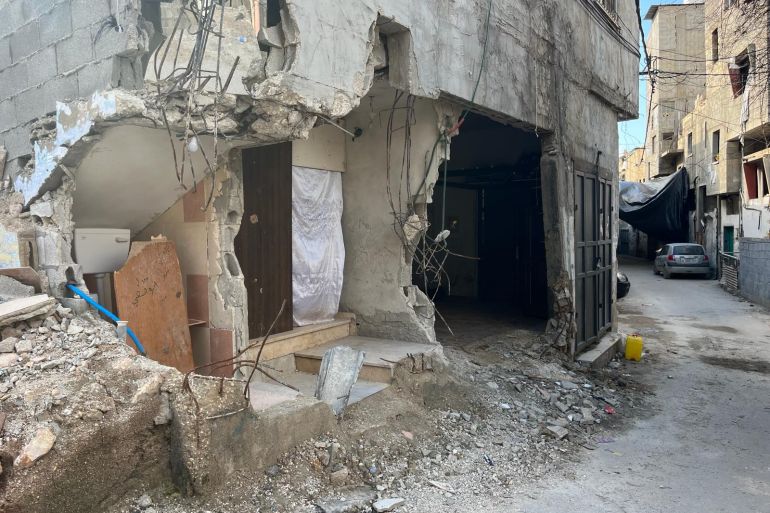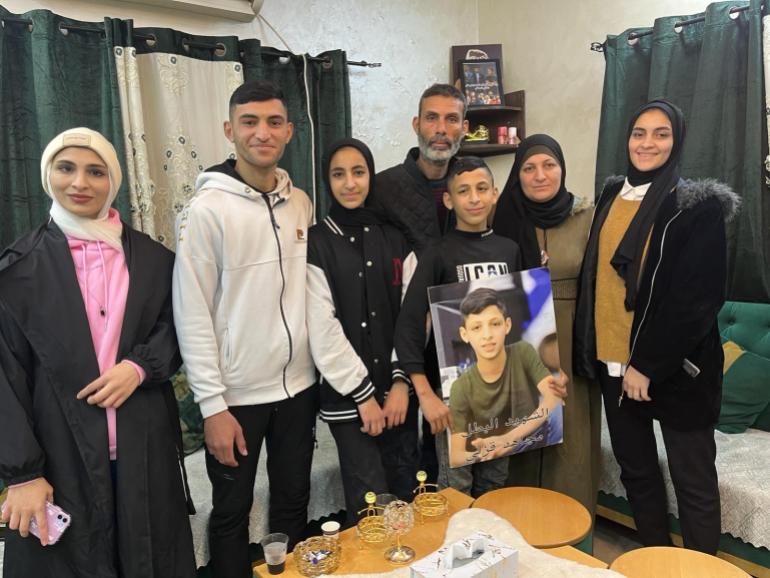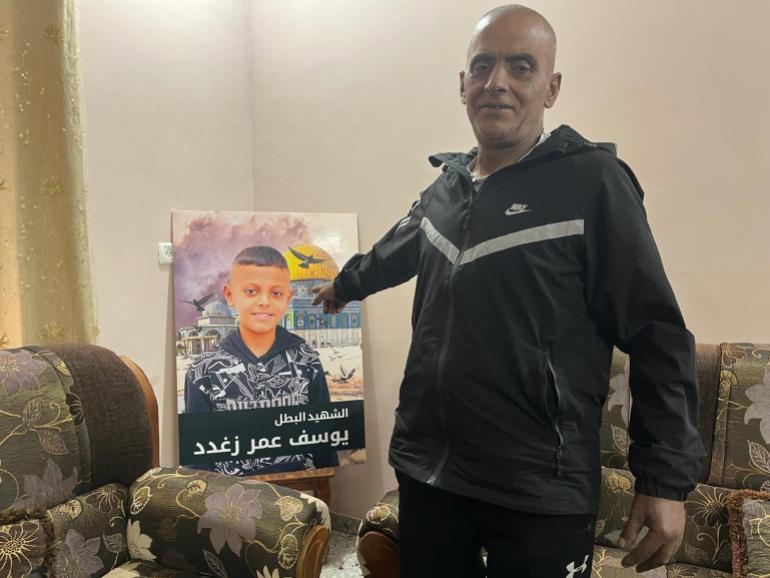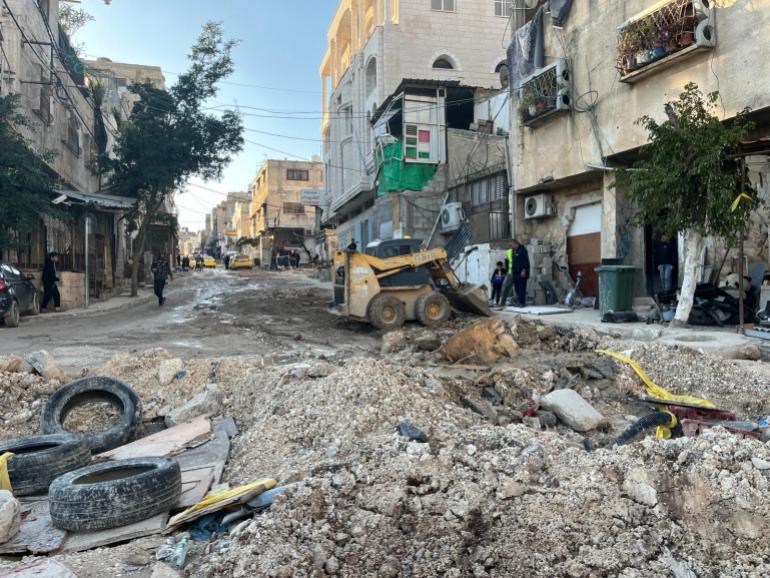‘Little Gaza’: Mourning loved ones Israel killed in West Bank refugee camps
Israel’s attacks in the occupied West Bank have killed both fighters and civilians, and left only destruction behind.

Tulkarem, occupied West Bank – “I saw him and I knelt over his body, not knowing what to do. All his face was bloody, full of shrapnel – and his leg was cut off.”
These are the words of Mohammad Saaida, whose 14-year-old son Mujahed was hit by an Israeli air strike while playing football with his friends in Nur Shams refugee camp in the northern occupied West Bank city of Tulkarem on October 19.
Keep reading
list of 4 itemsIsrael says bodies of three captives killed on October 7 recovered in Gaza
Will the Antisemitism Awareness Act repress free speech in the US?
Israeli far right sees victory as ‘ultimate annihilation of the Gaza Strip’
Immediately after the attack, Israeli forces prevented ambulances from reaching the teenager as he fought for his life for more than an hour, according to the Saaida family and the Palestine Red Crescent Society (PRCS). One ambulance was even hit by an Israeli army vehicle during the raid, according to the PRCS.
Four other boys were gravely injured in the attack and later died – along with eight other mostly young men.
Saaida – sitting with his wife, his two other sons and three daughters – recalled his deaf son Yousef running towards the family home carrying his younger brother’s body moments after the neighbourhood had been shaken by the loud explosion.
“I was standing outside near the corner where Mujahed was playing football with the other children when the missile was fired,” Saaida said. “Yousef ran towards me with Mujahed on his shoulder. He said the name of his brother – he was saying ‘Mujahed!’ I fell to my knees when I saw them. I knew what had happened.”
His brother’s name was one of the only words that Yousef, 25, had ever spoken – and one of the last his beloved sibling would ever hear.

Light of the sun
In Arabic, Nur Shams loosely translates to “the light of the sun”. But there has only been darkness and grief for those living in the besieged refugee camp since October 7.
Tulkarem is 105km (65 miles) away from the Gaza Strip, which has now endured relentless Israeli bombardment and a torturous blockade for more than five months.
More than 31,000 people – at least two-thirds of whom were women and children – have been killed by Israel’s assault on the enclave since Hamas’ October 7 attacks, during which 1,139 people were killed. Nearly 70,000 have also been wounded in Gaza.
Such is the gravity of devastation and loss of life in Gaza that a preliminary judgement at the United Nations’ International Court of Justice in December found cause to investigate charges that Israel is committing genocide.
Life in Tulkarem’s two refugee camps – Nur Shams and Tulkarem, home to a densely packed population of more than 40,000 people – has been tragic since the outbreak of war.
A few homes over from the Saaidas lives Omar Zaghdad, whose 11-year-old son Yousef was killed in the same air attack as Mujahed during the Israeli military’s three-day siege of Nur Shams.
“I knew my son was playing football in the street with his friends when I heard a big explosion,” Zaghdad said. “When I went outside, I saw six little bodies… Everyone was screaming and crying over them as they bled. All of them were young boys – dying for no reason.”
“Yousef was bleeding for an hour and a half. I begged the soldiers to let them take him to the hospital and they refused,” he added. “There were no ambulances, no doctors, no nurses. They stopped anyone coming to save them.”
Like the Saaida family, Zaghdad believes his son and the other boys would have survived the attack were it not for the army’s obstruction of emergency vehicles.

Israeli destruction
The Tulkarem Governate says at least 79 people have been killed by the Israeli military in the city since the outbreak of the war on Gaza.
Even in the occupied West Bank, where Gaza’s ruling Hamas has no authority, nearly 400 people – including more than 100 children – have been killed by Israeli forces since October 7, the Palestinian Health Ministry has reported.
In a series of interviews with Al Jazeera, the camp’s inhabitants repeatedly described Nur Shams as a “little Gaza”.
Walking through the streets, some of the scenes of destruction were not dissimilar to those televised to the world from Gaza – where at least 60 percent of civilian infrastructure has been either damaged or flattened.
Here in Tulkarem, homes are regularly demolished by Israel as residents – mostly descendants of those displaced from their homes in the forced expulsions of 1948’s Nakba – continue their lives among the rubble.
In the nearby Tulkarem camp, the roads have been so badly damaged by Israeli forces that they have been rendered practically unusable.
Scores of families from the camps are known to have been displaced, and now shelter in tents, schools or mosques.
Locals say there have been at least a dozen air strikes in the camps since October 7 – along with multiple large-scale raids.
Each time, Israeli forces prevented ambulances and healthcare workers from reaching those injured, charities such as the PRCS say.
Locals also say the military is targeting and killing journalists covering the events.
Al Jazeera contacted the Israeli military for comment on these incidents but received no response by the time of publication. At the time of the attack, the Israeli military said the October 19 air strike hit a group of Palestinians “that posed a threat to the soldiers in the area”.

Armed resistance
Just as in Jenin, Hebron and other regularly targeted West Bank cities, troops in Tulkarem seize homes and use them as military barracks and outposts as they lay siege to refugee neighbourhoods.
Residents believe Israel is waging war against the camps and is attempting to take advantage of the assault on Gaza to eradicate resistance groups in Tulkarem.
The camps are home to a group named the Tulkarem Brigade comprising fighters from the armed wings of Hamas, Fatah and the Palestinian Islamic Jihad – who have, at least for now, put aside their competing political objectives and visions for a future Palestine.
Speaking next to the flattened remains of the home he was born in, Yasser Shehadeh spoke to Al Jazeera about his 25-year-old son Ghaith, who was killed by an Israeli drone strike as he entered his car on December 17 in Nur Shams.
“His life is in Allah’s hands,” Shehadeh said. “Whatever God wrote for us, we will accept it.
“I didn’t cry any tears when I heard the news, but on the inside, I was in so much pain… Ghaith’s mother was devastated, but I can’t cry in front of anyone – I cry only by myself. I need to be strong for my family.”
Speaking of his son’s funeral, which was televised by Palestinian media and saw thousands take to the streets in mourning and protest, he added: “Ghaith’s farewell was like one for a president or a hero – everyone was there.
“Everybody saluted him because he was brave and strong.
“He sacrificed his life, his money, his situation for the cause of the Palestinian people – and I am so proud of him.”
Shehadeh did not reveal whether Ghaith was involved in any armed resistance activities. His brother Yarub – not part of any fighting group – has been in prison without charge for four months after Telegram, an encrypted messaging app, was found on his phone by soldiers at one of the West Bank’s more than 550 military checkpoints, according to his father.
Upwards of 7,000 people have been arrested in the West Bank – often without charge – since October 7, according to the Palestinian Prisoner’s Society.
‘We are their families’
Fighters and those close to them are unsurprisingly tight-lipped about their identities and affiliations. It is well-known, though, that the Tulkarem Brigade has become the dominant fighting group in the community. Fatah’s paramilitary wing, the Al-Aqsa Martyrs Brigades, also has a presence in the city.
While walking through Tulkarem camp, Al Jazeera encountered two fighters brandishing heavy-duty M16 rifles – the United States-made weapon of choice for so many Palestinian fighters.
Neither wanted to be identified to avoid reprisals.
“The people here empathise with the resistance,” the first of the fighters, who appeared to be in his 20s, said.
“They want someone to defend them against the occupation which is killing their children. We are their families. What we do is a normal reaction to defend our land and our country.”
The fighters said they were against the killing of Israeli civilians, saying it was “forbidden” in their religion.
“We are fighting for peace – not because we love fighting,” the same fighter said. “We had hopes and dreams for something more in life.
“We wish that when the little ones grow up all of this will be finished and there will be no need to hold more guns.”
‘Execution’
In Tulkarem camp, one-time fighter Mehraj Shehadeh, 48, described the “execution” of his 24-year-old son Jehad.
He was shot nearly 68 times by Israeli special forces while in a car at al-Maslakh roundabout in the east of the city on November 6. Three other passengers were killed in the attack.
His father said Jehad had decided to join the Tulkarem Brigade in his early 20s – which made him an obvious target for the Israeli military.
Pulling out his phone, Shehadeh showed graphic images of his barely recognisable son after the shooting.
“They shot Jehad in the head using about two whole magazines,” he said. “His head was empty. The doctor and I filled it in so we could recognise him… There were bullets planted in his skull. His eye wasn’t there.”
A video that was circulated on social media shows Jehad and three others in a silver car when Israeli forces ambush them. The soldiers fire machine guns at the vehicle, moving as close as the window before they stopped spraying bullets into Jehad’s lifeless body.
Shehadeh added: “When this young generation grows up seeing the existence of the occupation – the bombing, demolitions, genocides – there will always be those who resist.”
Mohaned Hamdallah, a community activist and resident of the nearby village of Anabta, drew parallels between the assault on Gaza and the treatment of the refugee camps in Tulkarem.
He said Tulkarem and nearby Jenin bear the brunt of the occupation’s violence due to their position near the Israeli border as well as the strength and embeddedness of their resistance groups.
“Most of the attacks in the West Bank are against the refugees in the camps,” he said.
“It is all part of Israel’s collective punishment. When they lose in Gaza, in just a few days they come to Nur Shams and then they go to Jenin.”
That collective punishment already led to the killing of 14-year-old Mujahed Saaida whose mother lamented him in haunting words: “Thank God – he has blessed me with patience,” Abeer Saaida said. “If it wasn’t for that, a woman in this situation would become crazy.”
“My son was still breathing. Maybe if they allowed the ambulance through, Mujahed could’ve been saved.
“Seeing my son dying on the ground with my own eyes is something no mother should have to suffer.”